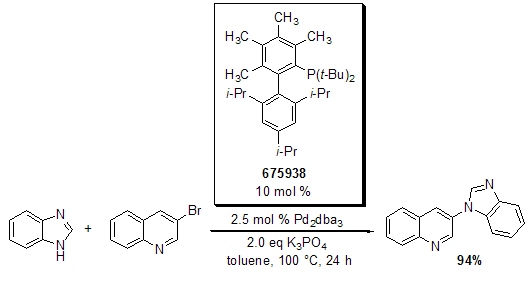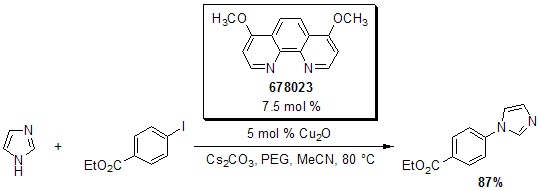Buchwald Phosphine Ligands
For C-C, C-N, and C-O Bond Formation:
Over the past several years, the Buchwald group has developed a series of bulky electron-rich phosphines that have garnered much attention for their ability to effect various C–C, C–N, and C–O bond formations.1 In particular, the SPhos and XPhos ligands have proven to be highly universal ligands for Suzuki-Miyaura reactions, especially with hindered aryl substrates and heteroaryl halides. In the case of XPhos, Pd-catalyzed coupling with unactivated aryl and heteroaryl chlorides is quite efficient. (Scheme 1).3

Scheme 1.
Additionally, tert-butyl XPhos and the tetramethyl analogue were recently reported to be excellent ligands for C–O and C–N bond formation. Both were reported to couple phenols with aryl and heteroaryl halides in high yields.4 Perhaps more significant, these ligands have been used in the direct Pd-catalyzed preparation of phenols from aryl bromides and chlorides using KOH as the nucleophile. The phenols can then be converted to alkyl aryl ethers via a one-pot procedure (Scheme 2).5

Scheme 2.
Buchwald and co-workers have also reported the use of these ligands in the arylations of 2-aminoheterocycles and difficult N-arylations of various N-containing heterocycles (Scheme 3).6

Scheme 3.
Although many methodologies have been developed for C–N coupling reactions, until recently there were no general methods available for the N-arylation of imidazoles. The Buchwald group at MIT has developed a mild and high-yielding approach to arylated imidazoles using catalytic Cu(I) and a 1,10-phenanthroline ligand scaffold (Scheme 4).7 The reaction allows the use of either an aryl bromide or iodide as the electrophile and is tolerant to bulky substituents and various sensitive functional groups.

Scheme 4.
Buchwald and co-workers have made significant advances in the area of mild Ullmann-type couplings of aryl halides with primary and secondary amines in the presence of CuI and a β-diketone ligand (Scheme 5).8 The scope of the reaction is rather mild and broad, allowing for heterocyclic structures in either coupling partner, wide functional group tolerance. Moreover, reactions of aryl iodides can typically be performed at ambient temperatures. Similarly, 2,2,6,6-tetramethyl-3,5-heptanedione has also been shown to be an effective ligand in the reaction.

Scheme 5.
Recently, the Buchwald group has reported complementary copper-catalyzed routes to N- or O-arylated amino alcohols.9 The use of the diketone ligand favors the formation of the N-arylated product (Scheme 6), while use of the tetramethylphenanthroline ligand favors the O-arylated product (Scheme 7). Ligand enhanced N-arylation was most selective for substrates with n ≥ 3, but could also be achieved in absence of the ligand when n = 2. O-arylation was most selective when n ≥ 4.

Scheme 6.

Scheme 7.
Buchwald and co-workers have also described the highly efficient synthesis of 5-membered ring heterocycles utilizing a one-pot Cu-catalyzed C–N coupling/hydroamidation procedure.10 Treatment of a haloenyne with tert-butyl carbamate or bis(tert-butoxycarbonyl)hydrazine in the presence catalytic CuI and a diamine ligand affords the corresponding pyrrole or pyrazole in high to excellent yield (Scheme 8). Alkenyl bromides and iodides are active in the domino reaction, and fused heterocyclic systems can be formed with ease (Figure 1).

Scheme 8.

Figure 1.
References
Para seguir leyendo, inicie sesión o cree una cuenta.
¿No tiene una cuenta?